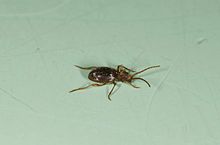|
Ptinus
Ptinus is a genus of beetles distributed throughout much of the world, including Africa, the Australian region, the Palearctic, the Near East, the Nearctic, and the Neotropical realm. It is a member of the subfamily Ptininae, the spider beetles. About 24 species have been found associated with stored food products in various parts of the world.[2] Both adults and larvae feed on grain, dried fruit, spices and other dried foodstuffs.[2] The species Ptinus tectus is considered a pest species in Museums and can damage stored objects and collections.[3] Taxa include:[4]  
See alsoReferencesWikimedia Commons has media related to Ptinus. Wikispecies has information related to Ptinus.
|
||||||||||||||||||||||||||||||||||
